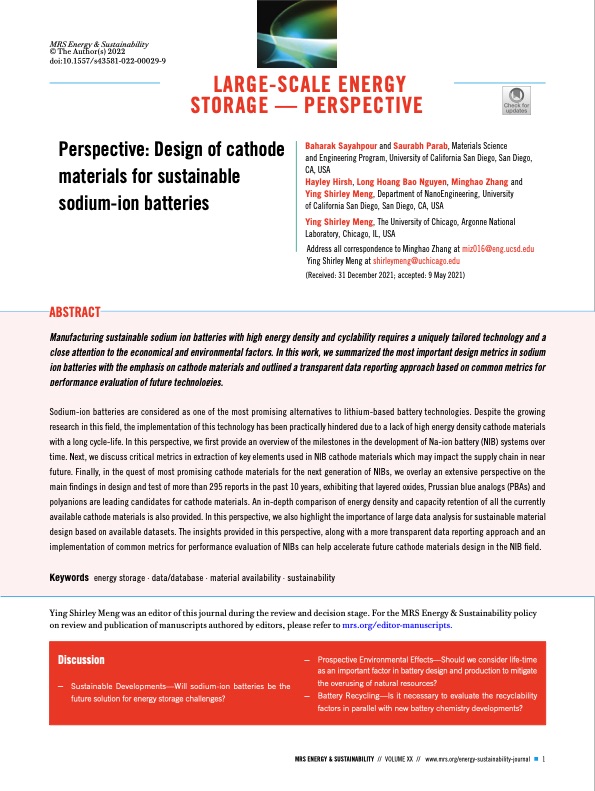
PDF Publication Title:
Text from PDF Page: 001
MRS Energy & Sustainability © The Author(s) 2022 doi:10.1557/s43581-022-00029-9 Perspective: Design of cathode materials for sustainable sodium‐ion batteries ABSTRACT Baharak Sayahpour and Saurabh Parab, Materials Science and Engineering Program, University of California San Diego, San Diego, CA, USA Hayley Hirsh, Long Hoang Bao Nguyen, Minghao Zhang and Ying Shirley Meng, Department of NanoEngineering, University of California San Diego, San Diego, CA, USA Ying Shirley Meng, The University of Chicago, Argonne National Laboratory, Chicago, IL, USA Address all correspondence to Minghao Zhang at miz016@eng.ucsd.edu Ying Shirley Meng at shirleymeng@uchicago.edu (Received: 31 December 2021; accepted: 9 May 2021) LARGE‐SCALE ENERGY STORAGE — PERSPECTIVE Manufacturing sustainable sodium ion batteries with high energy density and cyclability requires a uniquely tailored technology and a close attention to the economical and environmental factors. In this work, we summarized the most important design metrics in sodium ion batteries with the emphasis on cathode materials and outlined a transparent data reporting approach based on common metrics for performance evaluation of future technologies. Sodium-ion batteries are considered as one of the most promising alternatives to lithium-based battery technologies. Despite the growing research in this field, the implementation of this technology has been practically hindered due to a lack of high energy density cathode materials with a long cycle-life. In this perspective, we first provide an overview of the milestones in the development of Na-ion battery (NIB) systems over time. Next, we discuss critical metrics in extraction of key elements used in NIB cathode materials which may impact the supply chain in near future. Finally, in the quest of most promising cathode materials for the next generation of NIBs, we overlay an extensive perspective on the main findings in design and test of more than 295 reports in the past 10 years, exhibiting that layered oxides, Prussian blue analogs (PBAs) and polyanions are leading candidates for cathode materials. An in-depth comparison of energy density and capacity retention of all the currently available cathode materials is also provided. In this perspective, we also highlight the importance of large data analysis for sustainable material design based on available datasets. The insights provided in this perspective, along with a more transparent data reporting approach and an implementation of common metrics for performance evaluation of NIBs can help accelerate future cathode materials design in the NIB field. Keywords energy storage · data/database · material availability · sustainability Ying Shirley Meng was an editor of this journal during the review and decision stage. For the MRS Energy & Sustainability policy on review and publication of manuscripts authored by editors, please refer to mrs.org/editor-manuscripts. Vol.:(0123456789) Discussion – Sustainable Developments—Will sodium-ion batteries be the future solution for energy storage challenges? – Prospective Environmental Effects—Should we consider life-time as an important factor in battery design and production to mitigate the overusing of natural resources? – Battery Recycling—Is it necessary to evaluate the recyclability factors in parallel with new battery chemistry developments? MRS ENERGY & SUSTAINABILITY // VOLUME XX // www.mrs.org/energy-sustainability-journal 1PDF Image | cathode materials for sustainable sodium‐ion batteries

PDF Search Title:
cathode materials for sustainable sodium‐ion batteriesOriginal File Name Searched:
PerspectiveDesignOfCathodeMate.pdfDIY PDF Search: Google It | Yahoo | Bing
Salgenx Redox Flow Battery Technology: Salt water flow battery technology with low cost and great energy density that can be used for power storage and thermal storage. Let us de-risk your production using our license. Our aqueous flow battery is less cost than Tesla Megapack and available faster. Redox flow battery. No membrane needed like with Vanadium, or Bromine. Salgenx flow battery
| CONTACT TEL: 608-238-6001 Email: greg@salgenx.com | RSS | AMP |